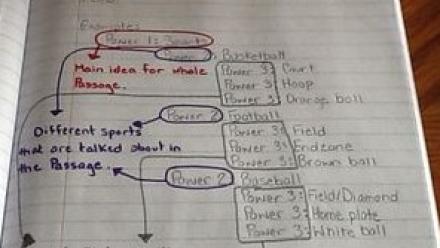Download a Graphic Organizer
Power Notes is a strategy that teaches students an efficient form of organizing information from assigned text. Students look for relationships within material they are reading while differentiating between hierarchies of importance. Power Notes visually display the differences between main ideas and supportive information in an outline form. Main ideas or categories are assigned a power 1 rating. Details and examples are assigned power 2s, 3s, or 4s.
Why use Power Notes?
Power Notes offer an easy to follow activity for categorizing information by its level of importance. The power structure helps students prioritize information and separate main ideas from supportive details, gives students an opportunity to organize ideas based on a hierarchical structure, and can be used to organize students’ writing. and evaluate their writing.
How to create and use the strategy
Begin by discussing your chosen topic or text. Describe the purpose of the strategy and introduce the concept of powers with a simple example familiar to the students like animals.
Power 1: Animals
Power 2: Dog
Power 3: Cocker Spaniel
Power 3: Dachshund
Power 2: Cat
Power 3: Siamese
Power 3: Calico
Point out to students how the powers relate to one another. Power 2’s offer examples or elaboration of power 1’s, power 3’s provide examples or elaboration of power 2’s, and so on.
- Once students are familiar with the power structure, they are ready to try it out with while reading. At first provide students with the Power 1 category or main idea but as students become more familiar with the power structure, students are able to determine Power 1s from the text.
- Students should begin by reading the assigned text keeping in mind the Power 1 category.
- Next, students should categorize information and record examples of the chosen category or topic as Power 2’s.
- Students can further elaborate each point and expand their writing by adding power 3 and Power 4 details.
- Make sure to leave time for students to discuss their completed Power Notes with partners for review and revising.
Power Notes are written using the following format:
Power 1 = Main Idea of the information.
Power 2 = Detail or supportive information for Power 1 above.
Power 3 = Detail or supportive information for Power 2 above.
Power 4 = Detail or supportive information for Power 3 above.
Tips for success
- MODEL! MODEL! MODEL! Students need a lot of practice organizing information into the power structure using their deductive and inductive thinking. Provide pairs or groups of students with cards that have power 1s, 2s, and 3s that need organizing so students can practice thinking about the power structure before applying it to their own ideas.
- Encourage students to use the power structure while taking notes and organizing their ideas for writing. This can give students a clear strategy to listening and organizing information that they are given during class or want to write about.
